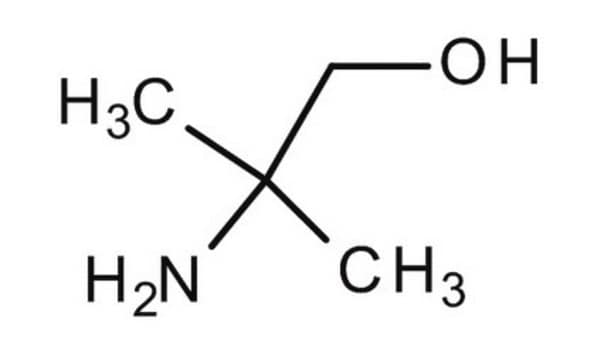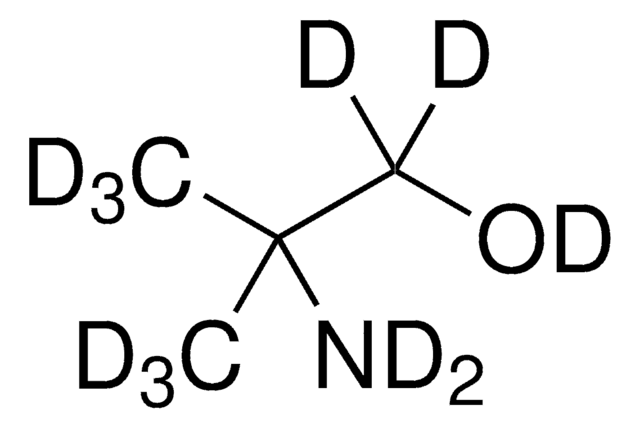A9199
2-Amino-2-methyl-1-propanol
BioXtra, ≥95%
Synonyme(s) :
β-Aminoisobutyl alcohol, AMP
About This Item
Produits recommandés
Densité de vapeur
3 (vs air)
Niveau de qualité
Pression de vapeur
<1 mmHg ( 25 °C)
Gamme de produits
BioXtra
Pureté
≥95%
Forme
liquid
Impuretés
≤0.005% Phosphorus (P)
≤0.1% Insoluble matter
Résidus de calcination
≤0.1%
Indice de réfraction
n20/D 1.4455 (lit.)
pH
11.0-12 (25 °C, 8.9 g/L)
Plage de pH utile
9.0-10.5
pKa (25 °C)
9.7
Point d'ébullition
165 °C (lit.)
Pf
24-28 °C (lit.)
Solubilité
H2O: 0.5 M at 20 °C, clear, colorless
Densité
0.934 g/mL at 25 °C (lit.)
Traces d'anions
chloride (Cl-): ≤0.05%
sulfate (SO42-): ≤0.05%
Traces de cations
Al: ≤0.0005%
Ca: ≤0.0005%
Cu: ≤0.0005%
Fe: ≤0.0005%
K: ≤0.005%
Mg: ≤0.0005%
NH4+: ≤0.05%
Na: ≤0.005%
Pb: ≤0.001%
Zn: ≤0.0005%
Chaîne SMILES
CC(C)(N)CO
InChI
1S/C4H11NO/c1-4(2,5)3-6/h6H,3,5H2,1-2H3
Clé InChI
CBTVGIZVANVGBH-UHFFFAOYSA-N
Vous recherchez des produits similaires ? Visite Guide de comparaison des produits
Application
Actions biochimiques/physiologiques
Mention d'avertissement
Danger
Mentions de danger
Conseils de prudence
Classification des risques
Aquatic Chronic 3 - Eye Dam. 1 - Skin Irrit. 2
Code de la classe de stockage
11 - Combustible Solids
Classe de danger pour l'eau (WGK)
WGK 1
Point d'éclair (°F)
179.8 °F - closed cup
Point d'éclair (°C)
82.1 °C - closed cup
Équipement de protection individuelle
dust mask type N95 (US), Eyeshields, Faceshields, Gloves
Choose from one of the most recent versions:
Déjà en possession de ce produit ?
Retrouvez la documentation relative aux produits que vous avez récemment achetés dans la Bibliothèque de documents.
Les clients ont également consulté
Notre équipe de scientifiques dispose d'une expérience dans tous les secteurs de la recherche, notamment en sciences de la vie, science des matériaux, synthèse chimique, chromatographie, analyse et dans de nombreux autres domaines..
Contacter notre Service technique













